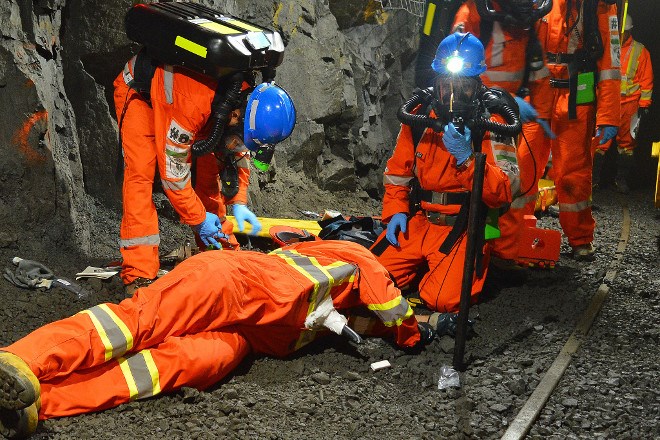In 2015, when it was announced that Sudbury would host the 2016 International Mines Rescue Competition (IMRC), Ontario Mine Rescue and Workplace Safety North — the lead coordinators for the event — had to decide exactly what they wanted the competition to be.
It was the first time the event was to be held in Canada, but after years of Ontario teams competing in other jurisdictions around the globe, they knew what they didn’t want: primarily, events that favoured the home community, a lack of transparency, and unrealistic simulations in an arena setting, said Ted Hanley, Ontario Mine Rescue’s general manager.
“Ontario had two teams that travelled to the Polish competition (in 2014), and while the logistics and the cultural exchange were fantastic, the big frustration was in the competition itself,” Hanley said during the 2017 Workplace Safety North mining conference, held in Sudbury in April. “It wasn’t challenging, and they didn’t learn anything.”
So, the two organizations set out to introduce elements that would not only challenge the competitors, but would, they hoped, also set the standard for future competitions.
That approach started right in the planning stages. First and foremost, they wanted the competition to be fair and transparent, and so rather than rely solely on Ontario’s rules and experts, they incorporated judges, technical volunteers, and rules from other jurisdictions.
“For the first time ever, we attempted…to look abroad and gathered input from international participants for how that competition should be run,” Hanley said.
The competition comprised 27 teams from 13 nations, for a total of 350 competitors and delegates, in addition to 117 technical judges and volunteers representing another six nations.
Hanley said that’s “far beyond the representation that any previous international competition has had.”
Teams participated in five group events and one individual event: high-angle rope rescue, underground firefighting, first aid, underground mine rescue, mine rescue theory, and the technician test.
Teams were given a two-day orientation, during which they were briefed on the events, allowed to practice on equipment, and ask the judges questions, so they could be best prepared for the competition.
During the underground firefighting event, held at a former underground equipment test facility, teams had to complete a simulated fire emergency. At previous competitions, teams would have to find their way through a simulated scenario with lights, smoke and visual impairment.
Instead, organizers set a real fire for competitors, which is not the standard training protocol for Ontario Mine Rescue. Yet, Hanley said, the competitors appreciated the realistic element.
“Not only were they not walking around in an arena, pretending to look for fires, there was real smoke, real heat, real conditions that they had to manage,” Hanley said. “They were able to demonstrate their technique and their decision-making underground.”
A number of other innovations were introduced at the event. During the underground mine rescue event, captains traded in their pencils and paper for a tablet device, in addition to using an attachment on their masks that allows for better communications between team members.
Teams also participated in a research project of the Centre for Research in Occupational Safety and Health (CROSH) by wearing a device during the event that tracked participants’ physiological responses live as they went into the exercise.
“It was very interesting to see live data come back from how that mine rescue volunteer was feeling,” Hanley said. “Something like this allows us to have an open discussion about the limits of rescue operations, the limits of training, so that we’re not doing more harm than good.”
At the end of the 10-day event, 21 awards were shared among 13 teams, with a roughly fair distribution amongst nations.
Russia will host the next International Mines Rescue Competition in 2018, and Hanley is hopeful the innovations introduced at the 2016 event won’t be abandoned.
Allowing cross-jurisdictional rules, incorporating realistic simulations, hosting an international panel of judges, and allowing cross-jurisdictional teams are all elements he believes are crucial to a fair, challenging and educational competition.
He also hopes to share the results of the 2016 event during the International Mines Rescue Body conference in Russia this year, so that their experience and their ideas can pass to others.
“We’re hoping to share the results of the competition so that these events don’t become little castles with trophies,” he said. “They become open books that you can read about for years, you can learn about, you can prepare for, and the teams can be rewarded for their hard work.”




